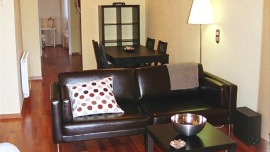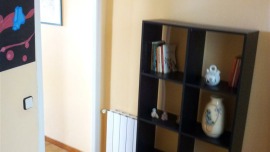
Apartment Carrer del Vallespir
Barcelona → Sants, Sants-Montjuïc • 2.4 mi ( 3.9 km ) from Sagrada Familia


The Basílica i Temple Expiatori de la Sagrada Família (Catalan pronunciation: [səˈɣɾaðə fəˈmiɫiə]; English: Basilica and Expiatory Church of the Holy Family), is a large Roman Catholic church in Barcelona, Spain, designed by Catalan architect Antoni Gaudí (1852–1926). Although incomplete, the church is a UNESCO World Heritage Site, and in November 2010 Pope Benedict XVI consecrated and proclaimed it a minor basilica, as distinct from a cathedral which must be the seat of a bishop.
Construction of Sagrada Família had commenced in 1882 and Gaudí became involved in 1883, taking over the project and transforming it with his architectural and engineering style, combining Gothic and curvilinear Art Nouveau forms. Gaudí devoted his last years to the project, and at the time of his death at age 73 in 1926 less than a quarter of the project was complete. Sagrada Família's construction progressed slowly, as it relied on private donations and was interrupted by the Spanish Civil War, only to resume intermittent progress in the 1950s. Construction passed the midpoint in 2010 with some of the project's greatest challenges remaining and an anticipated completion date of 2026, the centenary of Gaudí's death.
The basílica has a long history of dividing the citizens of Barcelona: over the initial possibility it might compete with Barcelona's cathedral, over Gaudí's design itself, over the possibility that work after Gaudí's death disregarded his design, and the recent proposal to build an underground tunnel of Spain's high-speed rail link to France which could disturb its stability.
Describing Sagrada Família, art critic Rainer Zerbst said, "It is probably impossible to find a church building anything like it in the entire history of art" and Paul Goldberger called it, "The most extraordinary personal interpretation of Gothic architecture since the Middle Ages."
The Basilica of the Sagrada Família was the inspiration of a bookseller, Josep Maria Bocabella, founder of Asociación Espiritual de Devotos de San José (Spiritual Association of Devotees of St. Joseph). After a visit to the Vatican in 1872, Bocabella returned from Italy with the intention of building a church inspired by that at Loreto. The apse crypt of the church, funded by donations, was begun 19 March 1882, on the festival of St. Joseph, to the design of the architect Francisco de Paula del Villar, whose plan was for a Gothic revival church of a standard form. The apse crypt was completed before Villar's resignation on 18 March 1883, when Gaudí assumed responsibility for its design, which he changed radically. Antoni Gaudí began work on the church in 1883 but was not appointed Architect Director until 1884.
On the subject of the extremely long construction period, Gaudí is said to have remarked: "My client is not in a hurry." When Gaudí died in 1926, the basilica was between 15 and 25 percent complete. After Gaudí's death, work continued under the direction of Domènec Sugrañes i Gras until interrupted by the Spanish Civil War in 1936. Parts of the unfinished basilica and Gaudí's models and workshop were destroyed during the war by Catalan anarchists. The present design is based on reconstructed versions of the plans that were burned in a fire as well as on modern adaptations. Since 1940 the architects Francesc Quintana, Isidre Puig Boada, Lluís Bonet i Gari and Francesc Cardoner have carried on the work. The illumination was designed by Carles Buigas. The current director and son of Lluís Bonet, Jordi Bonet i Armengol, has been introducing computers into the design and construction process since the 1980s. Mark Burry of New Zealand serves as Executive Architect and Researcher. Sculptures by J. Busquets, Etsuro Sotoo and the controversial Josep Subirachs decorate the fantastical façades.
The central nave vaulting was completed in 2000 and the main tasks since then have been the construction of the transept vaults and apse. As of 2006, work concentrated on the crossing and supporting structure for the main tower of Jesus Christ as well as the southern enclosure of the central nave, which will become the Glory façade.
The main nave was covered and an organ installed in mid-2010, allowing the still unfinished building to be used for religious services. The church was consecrated by Pope Benedict XVI on 7 November 2010 in front of a congregation of 6,500 people. A further 50,000 people followed the consecration Mass from outside the basilica, where more than 100 bishops and 300 priests were on hand to offer Holy Communion.
On 19 April 2011, an arsonist started a small fire in the sacristy which forced the evacuation of tourists and construction workers; the sacristy was damaged, and the fire took 45 minutes to contain.
The style of la Sagrada Família is variously likened to Spanish Late Gothic, Catalan Modernism and to Art Nouveau or Catalan Noucentisme. While the Sagrada Família falls within the Art Nouveau period, Nikolaus Pevsner points out that, along with Charles Rennie Macintosh in Glasgow, Gaudí carried the Art Nouveau style far beyond its usual application as a surface decoration.
While never intended to be a cathedral (seat of a bishop), the Sagrada Família was planned from the outset to be a cathedral-sized building. Its ground-plan has obvious links to earlier Spanish cathedrals such as Burgos Cathedral, Leon Cathedral and Seville Cathedral. In common with Catalan and many other European Gothic cathedrals, the Sagrada Família is short in comparison to its width, and has a great complexity of parts, which include double aisles, an ambulatory with a chevet of seven apsidal chapels, a multitude of towers and three portals, each widely different in structure as well as ornament. Where it is common for cathedrals in Spain to be surrounded by numerous chapels and ecclesiastical buildings, the plan of this church has an unusual feature: a covered passage or cloister which forms a rectangle enclosing the church and passing through the narthex of each of its three portals. With this peculiarity aside, the plan, influenced by Villar's crypt, barely hints at the complexity of Gaudí's design or its deviations from traditional church architecture.
The church plan is that of a Latin cross with five aisles. The central nave vaults reach forty-five metres (150 ft) while the side nave vaults reach thirty metres (100 ft). The transept has three aisles. The columns are on a 7.5 metre (25 ft) grid. However, the columns of the apse, resting on del Villar's foundation, do not adhere to the grid, requiring a section of columns of the ambulatory to transition to the grid thus creating a horseshoe pattern to the layout of those columns. The crossing rests on the four central columns of porphyry supporting a great hyperboloid surrounded by two rings of twelve hyperboloids (currently under construction). The central vault reaches sixty metres (200 ft). The apse is capped by a hyperboloid vault reaching seventy-five metres (250 ft). Gaudí intended that a visitor standing at the main entrance be able to see the vaults of the nave, crossing, and apse; thus the graduated increase in vault loft.
There are gaps in the floor of the apse, providing a view down into the crypt below.
The columns of the interior are a unique Gaudí design. Besides branching to support their load, their ever-changing surfaces are the result of the intersection of various geometric forms. The simplest example is that of a square base evolving into an octagon as the column rises, then a sixteen-sided form, and eventually to a circle. This effect is the result of a three-dimensional intersection of helicoidal columns (for example a square cross-section column twisting clockwise and a similar one twisting counter-clockwise).
Essentially none of the interior surfaces are flat; the ornamentation is comprehensive and rich, consisting in large part of abstract shapes which combine smooth curves and jagged points. Even detail-level work such as the iron railings for balconies and stairways are full of curvaceous elaboration.
In 2010 an organ was installed in the presbytery by the Blancafort Orgueners de Montserrat organ builders. The instrument has 26 stops (1,492 pipes) on two manuals and a pedalboard.
To overcome the unique acoustical challenges posed by the church's architecture and vast size, several additional organs will be installed at various points within the building. These instruments will be playable separately (from their own individual consoles) and simultaneously (from a single mobile console), yielding an organ of some 8000 pipes when completed.
Themes throughout the decoration include words from the liturgy. The towers are decorated with words such as "Hosanna", "Excelsis", and "Sanctus"; the great doors of the Passion façade reproduce words from the Bible in various languages including Catalan; and the Glory façade is to be decorated with the words from the Apostles' Creed. The three entrances symbolize the three virtues: Faith, Hope and Love. Each of them is also dedicated to a part of Christ's life. The Nativity Façade is dedicated to his birth; it also has a cypress tree which symbolizes the tree of life. The Glory façade is dedicated to his glory period. The Passion façade is symbolic of his suffering. The apse tower bears Latin text of Hail Mary. All in all, the Sagrada Família is symbolic of the lifetime of Christ.
Areas of the sanctuary will be designated to represent various concepts, such as saints, virtues and sins, and secular concepts such as regions, presumably with decoration to match.
With six other Gaudí buildings in Barcelona, la Sagrada Família is a UNESCO World Heritage Site, as testifying "to Gaudí’s exceptional creative contribution to the development of architecture and building technology", "having represented el Modernisme of Catalonia" and "anticipated and influenced many of the forms and techniques that were relevant to the development of modern construction in the 20th century".
Visitors can access the Nave, Crypt, Museum, Shop, and the Passion and Nativity towers. While visitors could previously access the towers directly at no cost, their access currently is possible only by lift and a walk up the remainder of the towers, over the bridge between the towers and descent via the opposite tower by spiral staircase.
The construction budget for 2009 was €18 million.
t:source: http://cs.wikipedia.org/wiki/Sagrada_Família